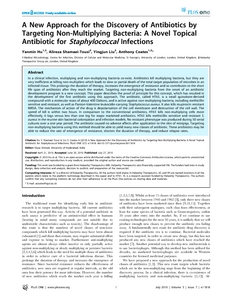Hu, Y; Shamaei-Tousi, A; Liu, Y; Coates, A
(2010)
A new approach for the discovery of antibiotics by targeting non-multiplying bacteria: a novel topical antibiotic for staphylococcal infections.
PLOS ONE, 5 (7).
e11818.
ISSN 1932-6203
https://doi.org/10.1371/journal.pone.0011818
SGUL Authors: Coates, Anthony Robert Milnes Hu, Yanmin
![[img]](https://openaccess.sgul.ac.uk/335/1.hassmallThumbnailVersion/pone.0011818.pdf)  Preview |
|
["document_typename_application/pdf; charset=binary" not defined]
Published Version
Download (1MB)
| Preview
|
Abstract
In a clinical infection, multiplying and non-multiplying bacteria co-exist. Antibiotics kill multiplying bacteria, but they are very inefficient at killing non-multipliers which leads to slow or partial death of the total target population of microbes in an infected tissue. This prolongs the duration of therapy, increases the emergence of resistance and so contributes to the short life span of antibiotics after they reach the market. Targeting non-multiplying bacteria from the onset of an antibiotic development program is a new concept. This paper describes the proof of principle for this concept, which has resulted in the development of the first antibiotic using this approach. The antibiotic, called HT61, is a small quinolone-derived compound with a molecular mass of about 400 Daltons, and is active against non-multiplying bacteria, including methicillin sensitive and resistant, as well as Panton-Valentine leukocidin-carrying Staphylococcus aureus. It also kills mupirocin resistant MRSA. The mechanism of action of the drug is depolarisation of the cell membrane and destruction of the cell wall. The speed of kill is within two hours. In comparison to the conventional antibiotics, HT61 kills non-multiplying cells more effectively, 6 logs versus less than one log for major marketed antibiotics. HT61 kills methicillin sensitive and resistant S. aureus in the murine skin bacterial colonization and infection models. No resistant phenotype was produced during 50 serial cultures over a one year period. The antibiotic caused no adverse affects after application to the skin of minipigs. Targeting non-multiplying bacteria using this method should be able to yield many new classes of antibiotic. These antibiotics may be able to reduce the rate of emergence of resistance, shorten the duration of therapy, and reduce relapse rates.
| Item Type: |
Article
|
| Additional Information: |
©2010 Hu et al. This is an open-access article distributed under the terms of the Creative Commons Attribution License, which permits unrestricted use, distribution, and reproduction in any medium, provided the original author and source are credited. |
| Keywords: |
Animals, Anti-Bacterial Agents, Anti-Infective Agents, Local, Female, Methicillin-Resistant Staphylococcus aureus, Mice, Mice, Inbred ICR, Microscopy, Electron, Transmission, Staphylococcal Infections, Staphylococcus aureus |
| SGUL Research Institute / Research Centre: |
Academic Structure > Infection and Immunity Research Institute (INII) |
| Journal or Publication Title: |
PLOS ONE |
| ISSN: |
1932-6203 |
| PubMed ID: |
20676403 |
| Web of Science ID: |
20676403 |
  |
Download EPMC Full text (PDF)
|
 |
Download EPMC Full text (HTML)
|
 |
Go to PubMed abstract |
| URI: |
https://openaccess.sgul.ac.uk/id/eprint/335 |
| Publisher's version: |
https://doi.org/10.1371/journal.pone.0011818 |
Statistics
Item downloaded times since 08 Feb 2013.
Actions (login required)
 |
Edit Item |




